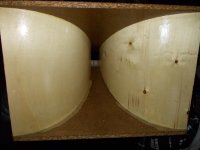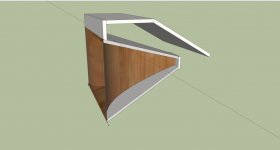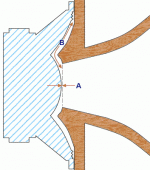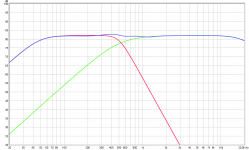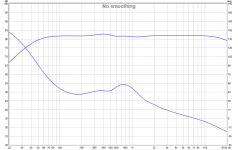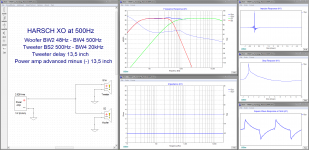Did just a part of what you did, only ask myself the horn is maybe unnecessary big.
Maybe better a smaller one and a sm,aller throat for more compression and a fill up of the cone bringing him close to mouth without ar only a small faseplug.
regards
Maybe better a smaller one and a sm,aller throat for more compression and a fill up of the cone bringing him close to mouth without ar only a small faseplug.
regards
Attachments
One reason why I am exploring the smaller uTrynergy - smaller and more manageable size. The phase plug design you draw there has a sharp lip where flows from edge of cone has to make a turn. That distance vs center of cone will make a sharp cancellation. I had a pretty deep one when I put 10F on the little 1.4in throat of the smaller uTrynergy.
One reason why I am exploring the smaller uTrynergy - smaller and more manageable size. The phase plug design you draw there has a sharp lip where flows from edge of cone has to make a turn. That distance vs center of cone will make a sharp cancellation. I had a pretty deep one when I put 10F on the little 1.4in throat of the smaller uTrynergy.
Where was that cancelation? frq?.
Maybe the filter way of correction is the only way, but curiousity of mine do let me try. Oke the small mouth = more compression is not very good idea, except maybe with a powerfull speaker motor and stiff cone.
What cuttoff frq has your smaller horn? mine was set on 275 Hz and 12,25 cm2 throat.
regards
I was able to get it to go down to about 350Hz in actual measurement. I am crossing at 500Hz. The full scale design was 175Hz and this is half scale so 175Hzx2=350Hz is theoretical lowest horn loading frequency so that matches.
I like the Cubinergy 🙂.... pretty looking !
I finally bought chipboard for a first price/try... I have ideas about proofing the ports drilled in chipboard.
Is it ok to amplify first the 10F with just a cap as High Pass filter to test enclosure at ears ? Ok please, if I take the value of the cap for a 500 Hz XO before having active filter ?
Kees, you made exactly what I plan to do with chipboard above 🙂
I finally bought chipboard for a first price/try... I have ideas about proofing the ports drilled in chipboard.
Is it ok to amplify first the 10F with just a cap as High Pass filter to test enclosure at ears ? Ok please, if I take the value of the cap for a 500 Hz XO before having active filter ?
Kees, you made exactly what I plan to do with chipboard above 🙂
I was able to get it to go down to about 350Hz in actual measurement. I am crossing at 500Hz. The full scale design was 175Hz and this is half scale so 175Hzx2=350Hz is theoretical lowest horn loading frequency so that matches.
Rule is 1/2 to one octave below calculated horn loading I did read somewhere.
Dit you also sim the bass alone to see how high it will go through the ports>?.
The dipole opening behing the horn I think is not critical, it do not work like a ported
box, I think a closed box do also wel when used to 80 hz like me.
regards
Last edited:
Do you think this open baffle concept is feasable with the faitalpro/6.5" combo?
Yes, even more so as the 6.5in drivers I was using are high Qts. In a way it is almost a hybrid short TL as the channel tapers down. Putting my hand or standing behind the box, the rear vent has a huge pressure wave coming out.
I like the Cubinergy 🙂.... pretty looking !
I finally bought chipboard for a first price/try... I have ideas about proofing the ports drilled in chipboard.
Is it ok to amplify first the 10F with just a cap as High Pass filter to test enclosure at ears ? Ok please, if I take the value of the cap for a 500 Hz XO before having active filter ?
Kees, you made exactly what I plan to do with chipboard above 🙂
If you have active you don't need the added complexity of the cap as a high pass filter. You are adding a reactive load to the amplifier chain - not that it matters with the 10F.
The cube shape has another practical use: I can rotate the speaker about is axis for more or less coverage. With the curved walls on sides - the coverage is wider. With the straight walls on sides it is narrower.
Last edited:
No I have not the active already and want to listen it before choosing my active set up (An Asus 7.1 with switchable muse oap I think !) That's what I ask if a XO with a cap at 500 hZ is enough to protect the driver (my amp is 250 W at 8 ohms, double at 4 !) for a first listening before I have time or will to buy the active stuff !
Last edited:
Time domain and frequency domain contain exact same information.
Yes, they do, what does that have to do with anything here?
It's not nonsense. Please, take a frequency response data curve of a system that has energy continuing beyond Nyquist of the measurement system and then IFFT it back to it impulse response. You will see ringing. Ringing (also know as Gibbs effect) IS part of the time domain equivalent of frequency domain energy that is suddenly bandlimited. The assumption when using a DFT/FFT and equating frequency domain and time domain representations is that the energy of the system measured is gone before the frequency of half the sample rate, otherwise you get artifacts.
As I said the result shown could be either (or both).
Last edited:
There are those who say proper transients in loudspeakers only happens with a sealed box or IB. What do you think of this? I ask only because the idea of an OB / Trynergy...synergy is now on the table.
uTrynergy with SB65WBAC25-4 driver and improved XO
The nice thing with an open back speaker is that it's easy to swap out the driver. I decided to try one of my favorite full range drivers: the SB Acoustics 2.5in SB65WBAC25-4. It's an aluminum cone driver with a Nd motor and nice top end and very little ringing. It is a bit lower in sensitivity than the Tang Band but that is not an issue as we are trying to integrate with woofers that are inherently lower in sensitivity.
Here are photos of the new driver and the speaker now with a foam core face lift to give a clean appearance from the front. I also added some foam around the rear exit reduce reflections back onto the full range cone and to smooth out the bass from the back.
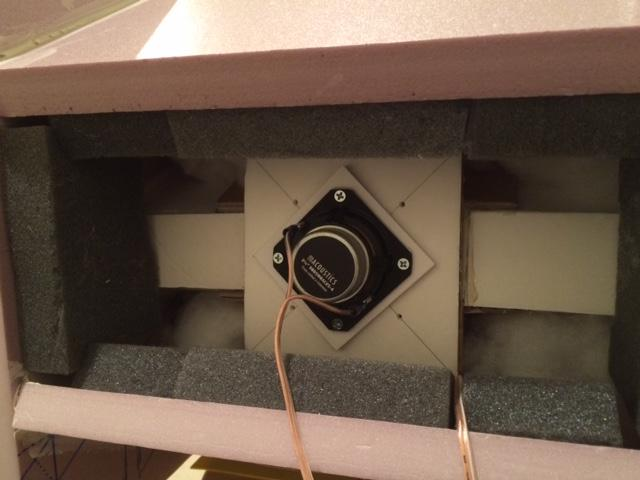

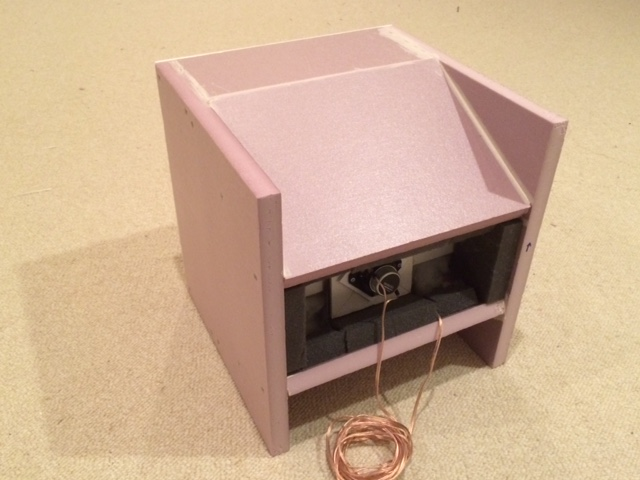
I also decided to use this opportunity to do the Harsch XO properly by measuring the raw response of the drivers separately and in parallel, driven full range to acquire the .FRD files (minimum phase converted) so that I can simulate the response in Jeff Bagby's PCD spreadsheet to determine the acoustic offset and to apply PEQ's to match a target function. I am glad I did this - it's a methodical process with clear steps that has no guesswork. Once I put the FRD files in PCD, I was able to quickly determine that the acoustic offset is 170mm to get an exact match of the combined response with the measured combined response acoustic interferogram.
I set the target functions as BW4 LPF at 500Hz for the woofer and BES2 HPF at 500Hz for the SB65WBAC25. It was quite surprising to find that the proper electronic filter ended up as a BW2 LPF at 500Hz for the woofer and a BW1 HPF at 300Hz for the SB65WBAC25. After applying 5 to 6 bands of PEQ, the target responses matched almost spot-on. The delay was also found to be only 100ms vs the 920ms I was using before.
Here are the predicted responses for the drivers and summed response from PCD:
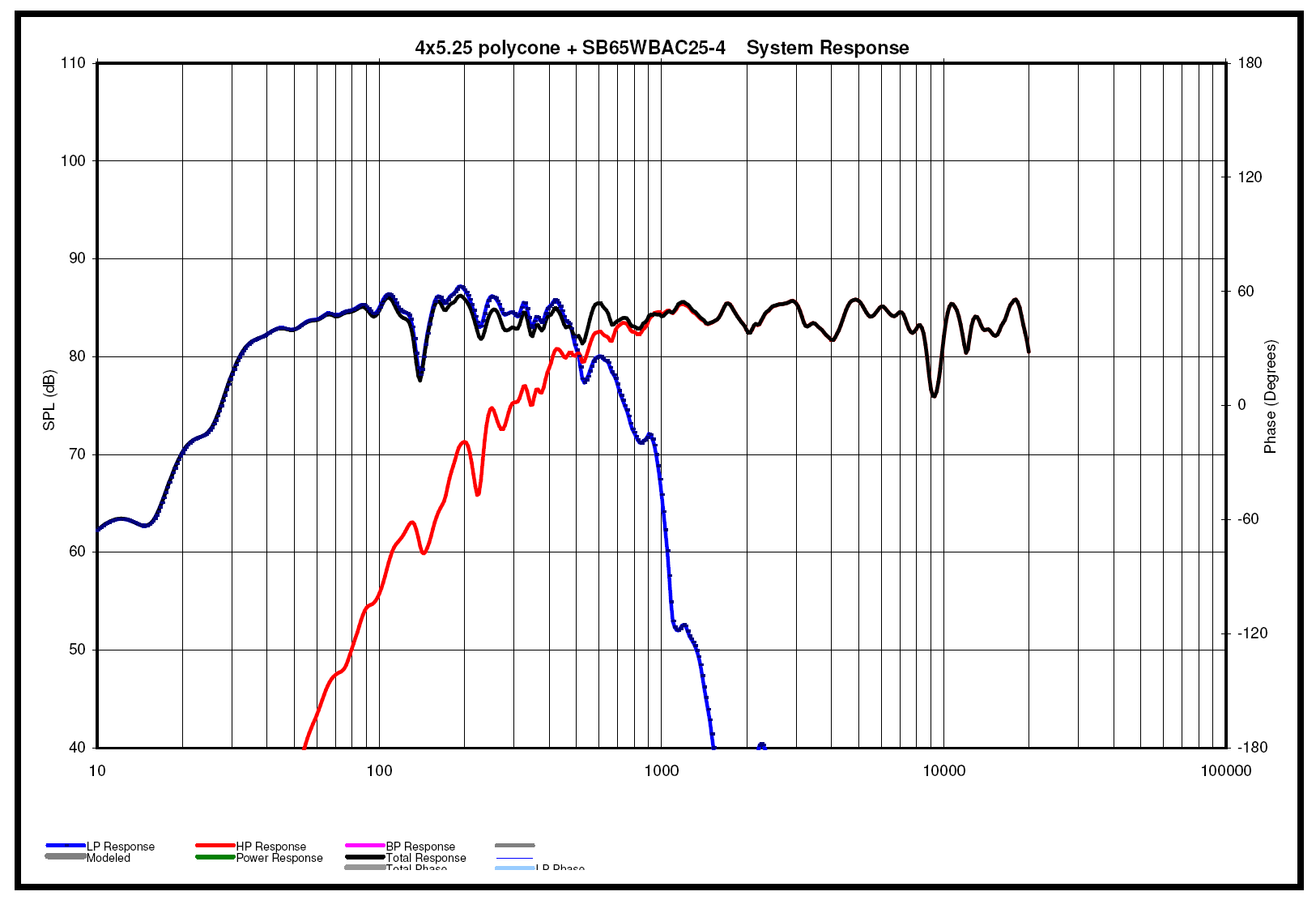
I then transferred to settings from PCD into miniDSP verbatim and here are the measured responses and the predicted response from PCD (light blue) - fantastic agreement:
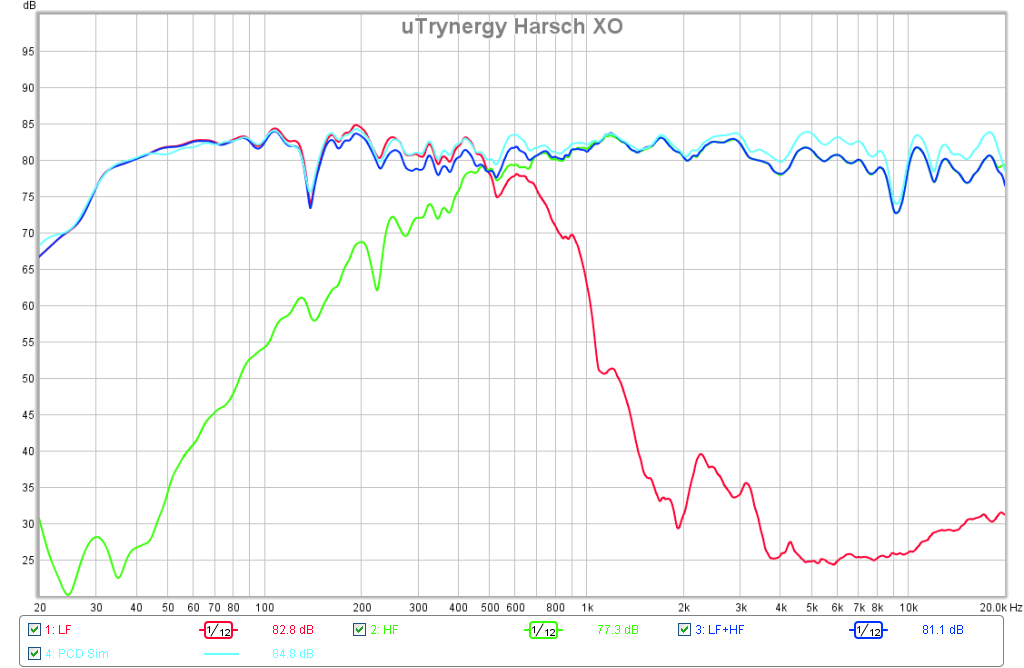
Here is the measured phase response of the new XO - extremely good near flat-phase response with +/- 25 deg over 200Hz to 8kHz. There is a phase wrap at 9kHz due to the horn-induced throat cancellation, otherwise it would have been flat phase to 20kHz. The delay as adjusted from the PCD simulation seems to have the peak phase shift occurring near 1khz rather than the 500Hz xo frequency - some more manual tweaking may be needed to move it to 500Hz:
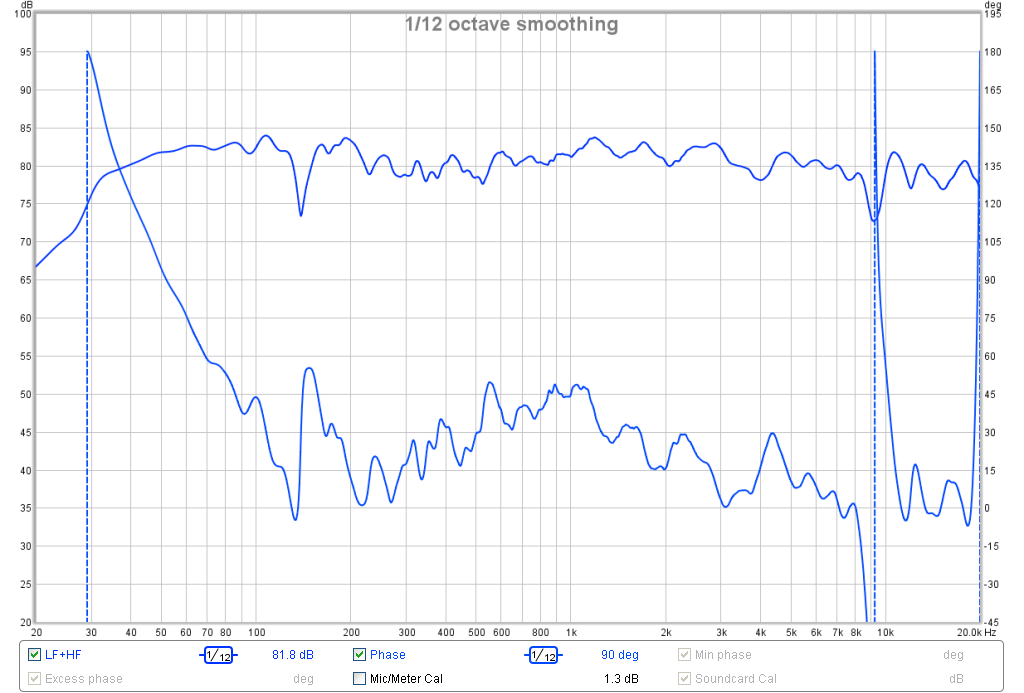
Here is the Impulse and Step Response, much better than I had previously:
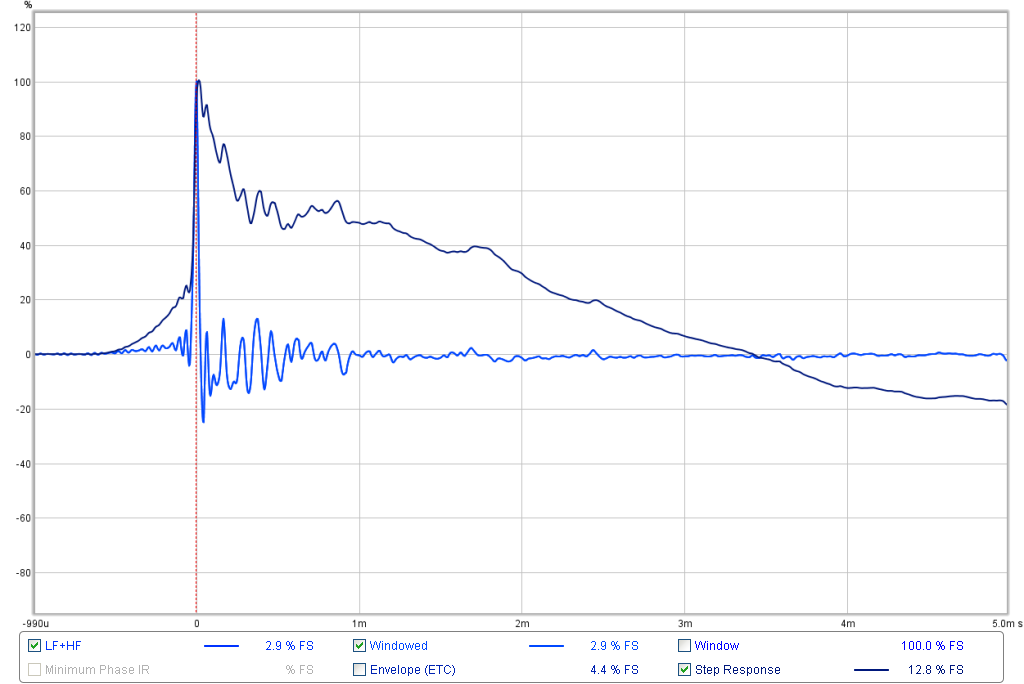
Here is the Distortion, and you can see that at lower domestic listening SPL's the distortion below 100Hz is under 2%. Also, this driver doesn't suffer from the big HD peak at 9kHz like the Tang Band did.
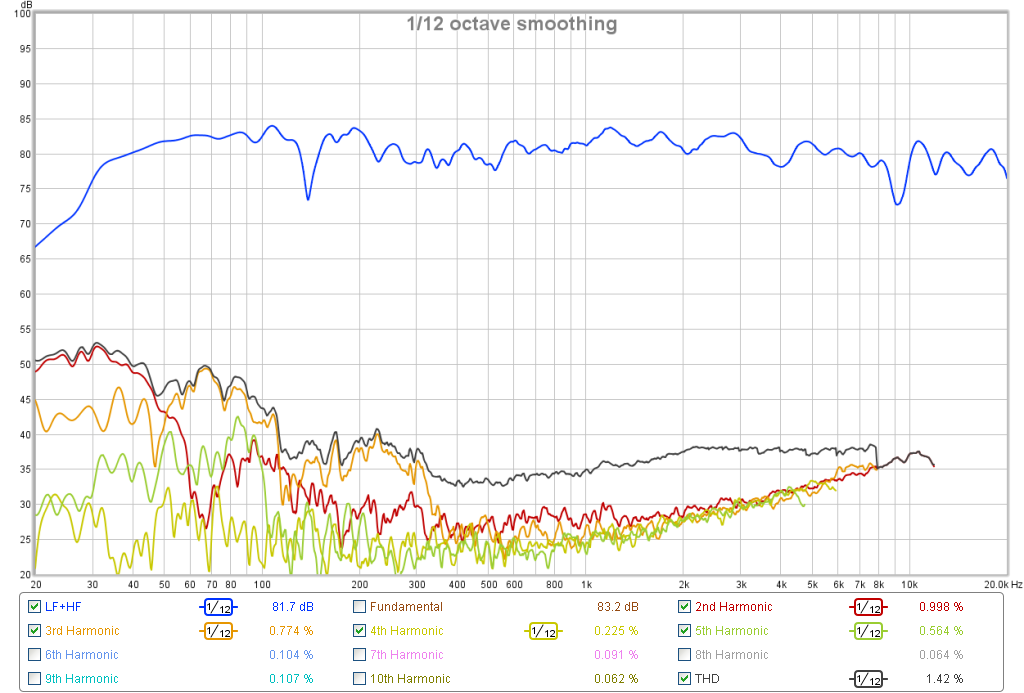
The sound is much more coherent than before - you really can hear the difference.
The nice thing with an open back speaker is that it's easy to swap out the driver. I decided to try one of my favorite full range drivers: the SB Acoustics 2.5in SB65WBAC25-4. It's an aluminum cone driver with a Nd motor and nice top end and very little ringing. It is a bit lower in sensitivity than the Tang Band but that is not an issue as we are trying to integrate with woofers that are inherently lower in sensitivity.
Here are photos of the new driver and the speaker now with a foam core face lift to give a clean appearance from the front. I also added some foam around the rear exit reduce reflections back onto the full range cone and to smooth out the bass from the back.



I also decided to use this opportunity to do the Harsch XO properly by measuring the raw response of the drivers separately and in parallel, driven full range to acquire the .FRD files (minimum phase converted) so that I can simulate the response in Jeff Bagby's PCD spreadsheet to determine the acoustic offset and to apply PEQ's to match a target function. I am glad I did this - it's a methodical process with clear steps that has no guesswork. Once I put the FRD files in PCD, I was able to quickly determine that the acoustic offset is 170mm to get an exact match of the combined response with the measured combined response acoustic interferogram.
I set the target functions as BW4 LPF at 500Hz for the woofer and BES2 HPF at 500Hz for the SB65WBAC25. It was quite surprising to find that the proper electronic filter ended up as a BW2 LPF at 500Hz for the woofer and a BW1 HPF at 300Hz for the SB65WBAC25. After applying 5 to 6 bands of PEQ, the target responses matched almost spot-on. The delay was also found to be only 100ms vs the 920ms I was using before.
Here are the predicted responses for the drivers and summed response from PCD:

I then transferred to settings from PCD into miniDSP verbatim and here are the measured responses and the predicted response from PCD (light blue) - fantastic agreement:

Here is the measured phase response of the new XO - extremely good near flat-phase response with +/- 25 deg over 200Hz to 8kHz. There is a phase wrap at 9kHz due to the horn-induced throat cancellation, otherwise it would have been flat phase to 20kHz. The delay as adjusted from the PCD simulation seems to have the peak phase shift occurring near 1khz rather than the 500Hz xo frequency - some more manual tweaking may be needed to move it to 500Hz:

Here is the Impulse and Step Response, much better than I had previously:

Here is the Distortion, and you can see that at lower domestic listening SPL's the distortion below 100Hz is under 2%. Also, this driver doesn't suffer from the big HD peak at 9kHz like the Tang Band did.

The sound is much more coherent than before - you really can hear the difference.
Attachments
-
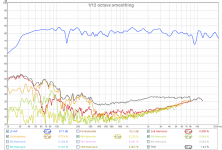 utrynergy-harsch-500hz-sb65wbac25-pcd-hd.png149.1 KB · Views: 2,700
utrynergy-harsch-500hz-sb65wbac25-pcd-hd.png149.1 KB · Views: 2,700 -
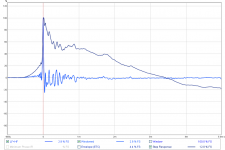 utrynergy-harsch-500hz-sb65wbac25-pcd-ir-sr.png55.4 KB · Views: 2,906
utrynergy-harsch-500hz-sb65wbac25-pcd-ir-sr.png55.4 KB · Views: 2,906 -
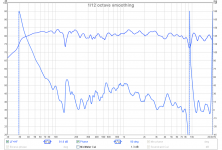 utrynergy-harsch-500hz-sb65wbac25-pcd-phase.png89.1 KB · Views: 3,379
utrynergy-harsch-500hz-sb65wbac25-pcd-phase.png89.1 KB · Views: 3,379 -
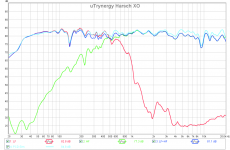 utrynergy-harsch-500hz-sb65wbac25-pcd-compare-meas.png88.3 KB · Views: 4,152
utrynergy-harsch-500hz-sb65wbac25-pcd-compare-meas.png88.3 KB · Views: 4,152 -
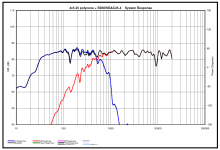 uTrynergy-Harsch-500Hz-SB65WBAC25-PCD-Simulation.PNG147.4 KB · Views: 1,542
uTrynergy-Harsch-500Hz-SB65WBAC25-PCD-Simulation.PNG147.4 KB · Views: 1,542 -
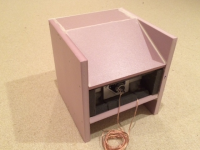 uTrynergy-SB65WBAC25-photo3.PNG478.9 KB · Views: 4,495
uTrynergy-SB65WBAC25-photo3.PNG478.9 KB · Views: 4,495 -
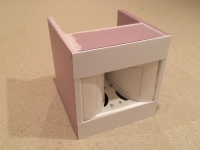 uTrynergy-SB65WBAC25-photo2.PNG439.1 KB · Views: 4,878
uTrynergy-SB65WBAC25-photo2.PNG439.1 KB · Views: 4,878 -
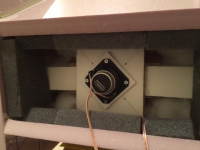 uTrynergy-SB65WBAC25-photo1.PNG399.1 KB · Views: 997
uTrynergy-SB65WBAC25-photo1.PNG399.1 KB · Views: 997
Last edited:
That's a pretty horn and a pretty response too, X.
I may play some with your foam construction method, working with a tablesaw here isn't so practical in a place that rains so much over the cooler seasons. What type are you using again? Is it practical to make angled edges on the cuts?
(BTW, do you ever sleep? I live out on the west coast, and see you posting at all hours, even being hours ahead of us here!)
I may play some with your foam construction method, working with a tablesaw here isn't so practical in a place that rains so much over the cooler seasons. What type are you using again? Is it practical to make angled edges on the cuts?
(BTW, do you ever sleep? I live out on the west coast, and see you posting at all hours, even being hours ahead of us here!)
With the delay added to woofers in front, does this cause an issue working in opposite coming out the back?
That's a pretty horn and a pretty response too, X.
I may play some with your foam construction method, working with a tablesaw here isn't so practical in a place that rains so much over the cooler seasons. What type are you using again? Is it practical to make angled edges on the cuts?
(BTW, do you ever sleep? I live out on the west coast, and see you posting at all hours, even being hours ahead of us here!)
Thanks! I don't sleep much - it gets in the way of diy! 🙂
I use Owens Corning "Foamular" home insulation sheathing (1.0in thick). I get it at HD. It comes in big 4x8 sheets but I like the 2x2 sheets as easier to transport home and they have nice square edges. I actually cut a bevel on it by hand with a razor. It holds angled cuts nicely and seems to make a fine speaker, albeit, light one. The trick is to use a sharp razor (fresh break off tips) and cut in multiple strokes slowly and smoothly.
This is indeed one of the better responses I have gotten - the phase is superb. Now I know that if one takes the time to do the XO following a textbook overlay, the results are well worth it. Cannot be done by eye...
But then you know this as you wrote Xsim.
With the delay added to woofers in front, does this cause an issue working in opposite coming out the back?
The delay is actually added to the tweeter, but even if applied to the woofer, would not matter to the back wave as the sound always leaves the cone as a dipole in phase (front and back side are one membrane). The sound out of the back just reflects off walls and adds ambiance so phase is not critical as it's all reflected stuff.
Now I know that if one takes the time to do the XO following a textbook overlay, the results are well worth it. Cannot be done by eye...
But then you know this as you wrote Xsim.
Actually, I do it by eye, never by any of the classical filter shapes!
.....This is indeed one of the better responses I have gotten - the phase is superb. Now I know that if one takes the time to do the XO following a textbook overlay, the results are well worth it. Cannot be done by eye....
Wow SB65WBAC25-4 version looks good and thanks for PCD guide here and over the other thread.
Did a quality check comparison your acoustic measurements to approx. same electric slopes made in Rephase and imported to REW and XSim. REW ones below is set same scales as your live ones for easy comparison, filters are electric woofer slopes BW2 48Hz - BW4 500Hz and tweeter slopes BS2 500Hz - 20kHz. In REW tweeter IR is delayed 1,0mS before summed A+B with woofer and in XSim tweeter is delayed 13,5 inch.
Attachments
Last edited:
No I have not the active already and want to listen it before choosing my active set up (An Asus 7.1 with switchable muse oap I think !) That's what I ask if a XO with a cap at 500 hZ is enough to protect the driver (my amp is 250 W at 8 ohms, double at 4 !) for a first listening before I have time or will to buy the active stuff !
It is more lilely to blow speakers then a modern amplifier these days.
XR I am go closed or helmholz for this reason a open baffle has a soft bas output while your horn is fast, this dipoles do even not put room modes on that is why she are interesting for nabures😛
also with such a system your speakers are not protected by big x max output when listen to for example a movie.
Try to load the woofer with the back port so it do act as a kind of tl or helmholz it will be a other story.
regards
- Home
- Loudspeakers
- Multi-Way
- Presenting the Trynergy - a full range tractrix synergy.
